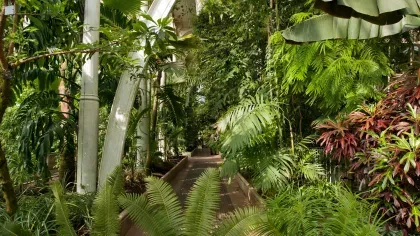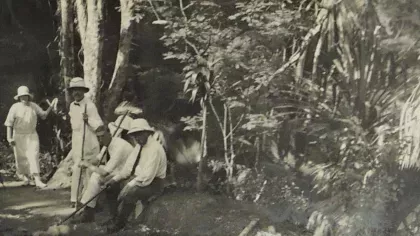10 March 2020
Kew and colonialism: A history of entanglement
How the collections reveal more about the practice of economic botany.
.jpg.webp?itok=dyqoXRWI)
The collections at Kew, both living and otherwise, reveal a history deeply entwined with colonialism, trade and the imperial project.
The practice of economic botany was key to the colonial era– finding plants across the globe that would massively increase Britain’s prosperity.
Kew’s Economic Botany Collection holds around 100,000 objects, from food and medicines to fuels, toys, weapons and materials. Most of the items date back to the British empire, when they were collected, exchanged or traded in a mission to document and exploit the world’s useful plants.
Today’s collection practices are deliberately and remarkably different, focusing on partnership and collaboration with global colleagues and peers.
Each object in the collection tells a story revealing a complex, and at times uncomfortable history.
 (1).jpg.webp?itok=x-EMlnR7)
The indigo factory model
For me, one of the most fascinating objects in Kew’s extensive collections is the indigo factory model.
Measuring 1.5m x 2m, and consisting of wooden models of factory buildings plus 100 clay figurines, it was commissioned by the British authorities in India for the Colonial and Indian Exhibition held in South Kensington in 1886.
At the close of the exhibition, the model was offered to Kew and exhibited in the Museum of Economic Botany. Today it can be found in the Sir Joseph Banks Building, where the Economic Botany Collection is now kept.
The model depicts the production of indigo dye in India.
There are four clay figurines of oxen, pulling the cart which delivers the raw indigo plants (Indigofera tinctoria); one European owner or manager wearing a pith helmet who stands on top of the vats, watching keenly; and 95 Indian workers occupied in various stages of the process by which indigo was converted from fresh green plants to blocks of blue indigo dye.

Indentured labour on display
The model was designed to promote Indian indigo to a global market and to encourage further investment in the plantation economy. When on display, it would demonstrate the process of indigo production.
What is clear from the model is that an integral part of that process was the cheap, local labour readily available to plantation managers in India.
Many of these labourers spent their working lives waist-deep in the vats of blue dye; usually they had few if any other options.
As the writer Jenny Balfour-Paul relates in her book, Indigo: Egyptian mummies to blue jeans, Indian farmers were effectively coerced by European planters into growing indigo in place of food crops, and labourers were brought to the European-run factories where they were kept in permanent debt through the indenture system – a contractual agreement which obliged them to work for a certain number of years in exchange for basic food, clothing and accommodation.
The indigo factory model tells a number of other stories too.
.jpg.webp?itok=TCIXQq72)
An artist acknowledged
The name of the artist – Rakhal Chunder Pal – is given on the model, which is an unusual example of individual recognition of colonial subjects in exhibitions at that time.
Pal (1834-1911) was an unusually skilled artist, coming from a Krishnagar family of award-winning clay modellers.
He won an award for this model at the Colonial and Indian Exhibition.
On closer inspection we can see how Pal has individualised the workers: labourers, overseers and administrative staff are depicted; they differ in physical appearance; and there are scenes of casual defiance of the rules.
Two of them seem to be involved in an argument; others chat to their colleagues through ventilation holes; or lounge in the shade, out of sight.
Pal has used his artistry to depict them as something more than cogs in an imperial machine.

.jpg.webp?itok=yPna5Vbi)
Commissioned with intent
The person who commissioned the model on behalf of the Indian Government tells us another story.
Trailokyanath Mukhopadhyay (1847-1919) (written as T.N. Mukharji in colonial records) was a Bengali civil servant in the Indian Department of Agriculture, a learned man of the Brahmin caste, a published author, and an assistant curator in the Arts and Economics Section of the Indian Museum, Kolkata.
.jpg.webp?itok=yE0huJgi)
He had the task of preparing the exhibits representing India at international exhibitions. He came to London for the 1886 exhibition and visited Kew Gardens.
He later published a book on his travels, A Visit to Europe (1889), which reveals that he was an outward-looking Indian who valued certain aspects of Indian tradition whilst advocating change in others, such as education.

A many-sided model
This model can be interpreted in different ways: as an artwork by a celebrated modeller; as an illustration of Indian industry; as a glimpse of daily life for many Indians under the Raj; or as a symbol of imperial rule.
Today it strikes many viewers as a depiction of the inequalities which marked so-called ‘extractive colonialism’, where the emphasis was more on benefit-taking from colonies than on benefit-sharing.
The indigo factory model is a controversial object, with the ability to allure and alarm in equal measure.
So why are we sharing its story?
Currently, Kew is in the middle of a journey; we are looking at our language, our collections, our scientific practices, our policies, and the histories we do and don’t tell about Kew’s entanglement with the British Empire.
The indigo factory story tells us that whilst Kew was not directly involved in forcing traditional Indian farmers to plant indigo, nor in building indigo processing plants or recruiting indentured labourers, it was nevertheless implicated in the promotion of the indigo trade through its Museum of Economic Botany that existed at the time.
In the words of the museum's founder Sir William Hooker, our purpose was to show plants and ‘the uses which the ingenuity of man has derived from them’ – and to harness them at quite a cost.

.jpg.webp?itok=XYh96deR)


